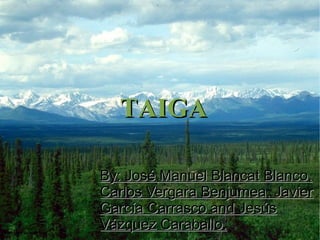
Taiga
- 1. TAIGA By: José Manuel Blancat Blanco, Carlos Vergara Benjumea, Javier García Carrasco and Jesús Vázquez Caraballo.
- 2. INDEX ● Main caracteristics......................................................pg 1. ● Localization and climate.............................................pg 2. ● Temperature................................................................pg 3. ● Precipitation and rainfall.............................................pg 4. ● Fauna..........................................................................pg 5. ● Vegetation or flora....................................................pg 12. ● Biography.................................................................pg 14.
- 3. MAIN CARACTERISTICS ● It´s form by coniferous forest and is the biggest woodland of the world. ● It´s can be call boreal forest in the southern zone and taiga in the northern zone. Generally high humidity lead to the formation of podzol type soils, acid soils that favor the formation of peatlands. The taiga, characterized by their low tree line, and consisting of coniferous forests are biomes typical cold weather in the northern hemisphere.
- 4. LOCALIZATION AND CLIMATE It´s locate in the north hemisphere . This natural landscape has a continental climate that is extremely cold and wet. Winters are short and cold, but often more stringent than in the tundra and the ground is covered with snow.
- 5. Climogram of the taiga
- 7. TEMPERATURE In the taiga, the average temperature is 19 ° C in summer and -30 ° C in winter with big differences in the temperature between summer and winter (in Siberia are normally reached temperatures below 40 º C in winter and higher than 15 º C in summer). The summer period is rather cool, with an average temperature of 19 º C, which favors the melting of frozen surfaces and hinders the normal movement of some animals.
- 8. PRECIPITATIONS AND RAINFALL The precipitation in the taiga is relatively high, and it falls as snow in winter and rain in summer. Annual rainfall in the taiga is between 250-750 mm per year in some areas with a minimum of 160 and in other maximum of 1000 mm; moreover, the water remains frozen many months.The temperatures are low throughout the year depending on each month can go a little bit or lower. Which is not very abundant although low temperatures produce low evaporation. The average temperature is below 0 to 5°C.
- 9. FAUNA ● The life of the animals is very hard in winters, birds emigrate to warm latitudes while other animals hibernate. ● The most characteristics animals are: Hervivorous animals, like reindeers,caribous or mooses. Rodents animals, like beavers, squirells or hares. Carnivorous animals, like wolves, foxes, gluttons and bears. Birds, like owls, barn owls, grouses, hazel hen and crossbills.
- 10. HERVIVOROUS CARIBOU MOOSE RAINDEER
- 11. RODENTS SQUIRELL BEAVER HARE
- 12. CARNIVOROUS BEAR WOLF GLUTTON
- 13. BARN OWL BIRDS HAZEL HEN OWL CROSSBILL GROUSE
- 14. VEGETATION OR FLORA ● The changing seasons called coniferous forests. When spring come alive coniferous forest is the natural vegetation of much of the warm zones of Europe and North America but also exist in the limited warm lands in the southern hemisphere. Some trees exceed the 40m of altitude, the most representative vegetation of the Taiga are : ● Trees, like pines, elms, oaks, poplars, firs, ash,... ● Plants, like honeysuckle, primroses and hyacinths.
- 15. TREES ASH PINES FIR ELM
- 16. PLANTS PRIMROSES HONEYSUCLE HYACINTHS